ParaCAD lab and as a teaching assistant. She also completed two internships in Hartford, Co
- 格式:pdf
- 大小:1.67 MB
- 文档页数:18
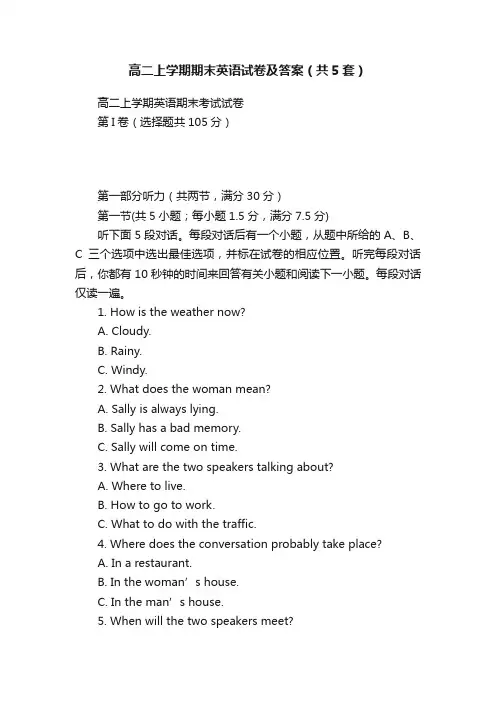
高二上学期期末英语试卷及答案(共5套)高二上学期英语期末考试试卷第I卷(选择题共105分)第一部分听力(共两节,满分30分)第一节(共5小题;每小题1.5分,满分7.5分)听下面5段对话。
每段对话后有一个小题,从题中所给的A、B、C三个选项中选出最佳选项,并标在试卷的相应位置。
听完每段对话后,你都有10秒钟的时间来回答有关小题和阅读下一小题。
每段对话仅读一遍。
1. How is the weather now?A. Cloudy.B. Rainy.C. Windy.2. What does the woman mean?A. Sally is always lying.B. Sally has a bad memory.C. Sally will come on time.3. What are the two speakers talking about?A. Where to live.B. How to go to work.C. What to do with the traffic.4. Where does the conversation probably take place?A. In a restaurant.B. In the woman’s house.C. In the man’s house.5. When will the two speakers meet?A. At 5:30.B. At 6:30.C. At 7:00第二节(共15小题;每小题1.5分,满分22.5分)听下面5段对话或独白。
每段对话或独白后有几个小题,从题中所给的A、B、C三个选项中选出最佳选项,并标在试卷的相应位置。
听每段对话或独白前,你将有时间阅读各个小题,每小题5秒钟;听完后,各小题将给出5秒钟的作答时间。
每段对话或独白读两遍。
听第6段材料,回答第6、7题。
6. Why does the woman feel sorry for the man?A. She refused his invitation.B. She didn’t meet him on time.C. She forgot to help him with his apartment.7. What do we know about Susan’s old apartment?A. It has two bedrooms.B. It’s on 1312 Rose Avenue.C. Its rent is $1.000 a month.请听第7段材料,回答第8,9题8. Why didn’t the woman write back to the man?A. She hasn’t checked her mail box yet.B. She didn’t receive the man’s e-mail.C. She has been busy all the morning.9. When will the two speakers meet?A. At 10am.B. At lunch time.C. At 2 pm.请听第8段材料,回答第10至12题。
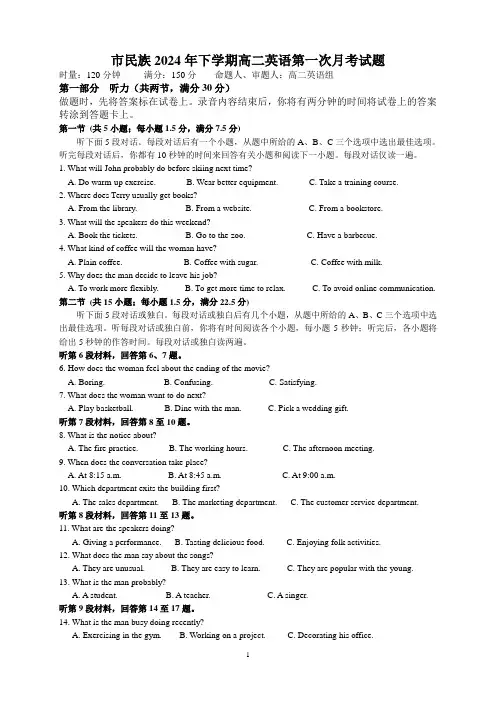
市民族2024年下学期高二英语第一次月考试题时量:120分钟满分:150分命题人、审题人:高二英语组第一部分听力(共两节,满分30分)做题时,先将答案标在试卷上。
录音内容结束后,你将有两分钟的时间将试卷上的答案转涂到答题卡上。
第一节(共5小题;每小题1.5分,满分7.5分)听下面5段对话。
每段对话后有一个小题,从题中所给的A、B、C三个选项中选出最佳选项。
听完每段对话后,你都有10秒钟的时间来回答有关小题和阅读下一小题。
每段对话仅读一遍。
1. What will John probably do before skiing next time?A. Do warm-up exercise.B. Wear better equipment.C. Take a training course.2. Where does Terry usually get books?A. From the library.B. From a website.C. From a bookstore.3. What will the speakers do this weekend?A. Book the tickets.B. Go to the zoo.C. Have a barbecue.4. What kind of coffee will the woman have?A. Plain coffee.B. Coffee with sugar.C. Coffee with milk.5. Why does the man decide to leave his job?A. To work more flexibly.B. To get more time to relax.C. To avoid online communication. 第二节(共15小题;每小题1.5分,满分22.5分)听下面5段对话或独白。
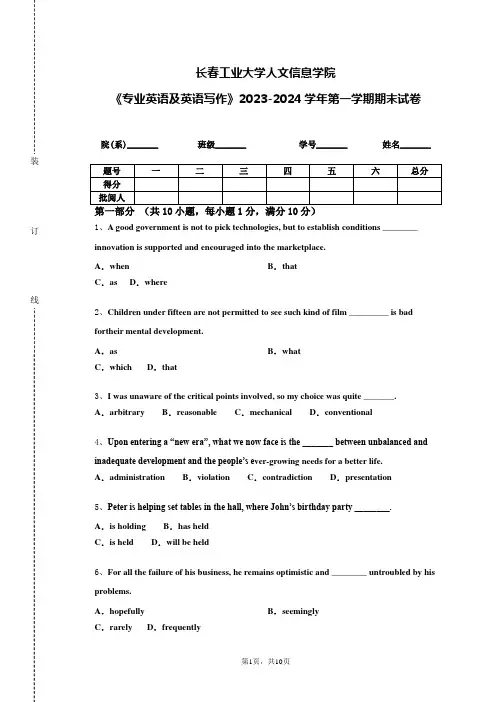
长春工业大学人文信息学院《专业英语及英语写作》2023-2024学年第一学期期末试卷院(系)_______ 班级_______ 学号_______ 姓名_______1、A good government is not to pick technologies, but to establish conditions ________ innovation is supported and encouraged into the marketplace.A.when B.thatC.as D.where2、Children under fifteen are not permitted to see such kind of film _________ is bad fortheir mental development.A.as B.whatC.which D.that3、I was unaware of the critical points involved, so my choice was quite _______. A.arbitrary B.reasonable C.mechanical D.conventional4、Upon entering a “new era”, what we now face is the _______ between unbalanced and inadequate development and the people’s e ver-growing needs for a better life. A.administration B.violation C.contradiction D.presentation5、Peter is helping set tables in the hall, where John’s birthday party ________.A.is holding B.has heldC.is held D.will be held6、For all the failure of his business, he remains optimistic and ________ untroubled by his problems.A.hopefully B.seeminglyC.rarely D.frequently7、The Dragon Boat Festival ________ the beginning of the hottest season of the year. A.is marking B.marks C.will mark D.marked8、I would appreciate you could come to my birthday party.A.that B.that it C.if D.it if9、The government officials met the workers and engineers working on the stadium,most____ were migrant workers.A.of which B.of who C.of whom D.of them10、Not until the bus disappeared in the distance ________ her school bag was gone. A.Tina had found B.had Tina foundC.did Tina find D.Tina found第二部分阅读理解(满分20分)阅读下列短文,从每题所给的A、B、C、D 四个选项中,选出最佳选项。
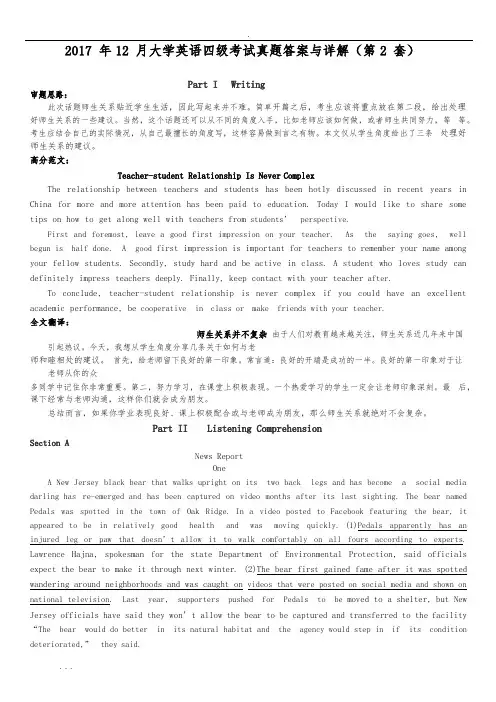
2017 年12 月大学英语四级考试真题答案与详解(第2 套)Part I Writing审题思路:此次话题师生关系贴近学生生活,因此写起来并不难。
简单开篇之后,考生应该将重点放在第二段,给出处理好师生关系的一些建议。
当然,这个话题还可以从不同的角度入手,比如老师应该如何做,或者师生共同努力,等等。
考生应结合自己的实际情况,从自己最擅长的角度写,这样容易做到言之有物。
本文仅从学生角度给出了三条处理好师生关系的建议。
高分范文:Teacher-student Relationship Is Never ComplexThe relationship between teachers and students has been hotly discussed in recent years in China for more and more attention has been paid to education. Today I would like to share some tips on how to get along well with teachers from students’ perspective.First and foremost, leave a good first impression on your teacher. As the saying goes, well begun is half done. A good first impression is important for teachers to remember your name among your fellow students. Secondly, study hard and be active in class. A student who loves study can definitely impress teachers deeply. Finally, keep contact with your teacher after.To conclude, teacher-student relationship is never complex if you could have an excellent academic performance, be cooperative in class or make friends with your teacher.全文翻译:师生关系并不复杂由于人们对教育越来越关注,师生关系近几年来中国引起热议。
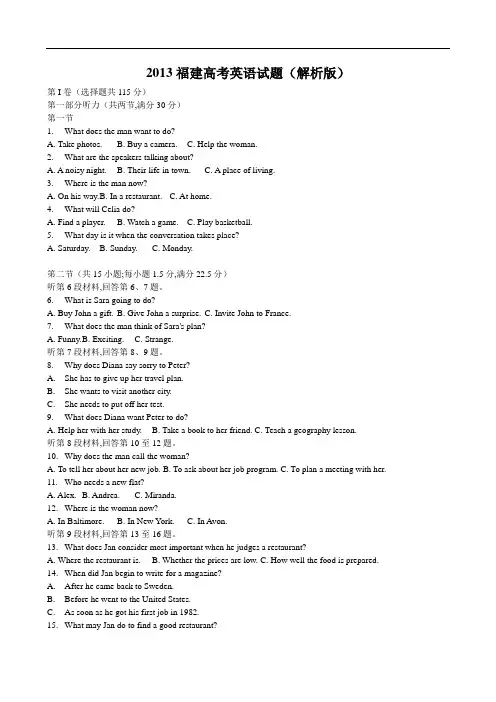
2013福建高考英语试题(解析版)第I卷(选择题共115分)第一部分听力(共两节,满分30分)第一节1. What does the man want to do?A. Take photos.B. Buy a camera.C. Help the woman.2. What are the speakers talking about?A. A noisy night.B. Their life in town.C. A place of living.3. Where is the man now?A. On his way.B. In a restaurant.C. At home.4. What will Celia do?A. Find a player.B. Watch a game.C. Play basketball.5. What day is it when the conversation takes place?A. Saturday.B. Sunday.C. Monday.笫二节(共15小题;每小题1.5分,满分22.5分)听第6段材料,回答第6、7题。
6. What is Sara going to do?A. Buy John a gift.B. Give John a surprise.C. Invite John to France.7. What does the man think of Sara's plan?A. Funny.B. Exciting.C. Strange.听第7段材料,回答第8、9题。
8. Why does Diana say sorry to Peter?A. She has to give up her travel plan.B. She wants to visit another city.C. She needs to put off her test.9. What does Diana want Peter to do?A. Help her with her study.B. Take a book to her friend.C. Teach a geography lesson.听第8段材料,回答第10至12题。

2022-2023高三上英语期末模拟试卷考生请注意:1.答题前请将考场、试室号、座位号、考生号、姓名写在试卷密封线内,不得在试卷上作任何标记。
2.第一部分选择题每小题选出答案后,需将答案写在试卷指定的括号内,第二部分非选择题答案写在试卷题目指定的位置上。
3.考生必须保证答题卡的整洁。
考试结束后,请将本试卷和答题卡一并交回。
第一部分(共20小题,每小题1.5分,满分30分)1.—Congratulations!I hear you’ve won the first prize in the s inging competition.—You _____ be mistaken.I’m in the dance class.A.must B.may C.should D.could2.The old road is indeed less direct and a bit longer. We won’t take the new one,_______, as we don’t feel safe on it.A.somehow B.otherwise C.therefore D.though3.—The T--shirt I received is not the same as is shown online.—________?But I promise you we’ll look into it right away.A.Who says B.How comeC.What for D.Why worry4.Della turned all of her pockets inside out only to find $ 1.87 buy Jim a present for Christmas.A.with what to B.with that she can C.in which to D.with which to 5.—Amazing! You wear slippers at work.—Don’t you know it’s a fashion?A.must B.should C.can D.may6.Life teaches us not to regret over yesterday, for it ________ and is beyond our control. A.passed B.will passC.has passed D.had passed7.After receiving the Oscar for Best Supporting Actress, Anne Benedict went on all the people who had helped in her career.A.to thank B.thankingC.having thanked D.to have thanked8.The matches of the FIFA Women’s World Cup will be played in 2019 all around France, whose men’s team _____ the 2018 World Cup.A.wins B.wonC.has won D.had won9.——Your argument is .I will not let you pass.--Are you kidding?A.sound B.rationalC.liberal D.plain10.Never turn down a job because you think it’s too small. You don’t know _____ it can lead.A.how B.whereC.whether D.what11.—What is your impression of your former colleague Nick?—He’s helpful, and he ________ give us a hand at wor k.A.must B.wouldC.may D.should12.In the US, there are currently over 5,000 community schools _____, in addition to serving as educational institutions, function as community centers for the surrounding neighborhood.A.which B.whereC.whose D.as13.The two brothers look so much alike that it is difficult to ______.A.tell them from B.tell from themC.tell apart them D.tell them apart14.Only when _________hard __________ make your dream come true.A.do you work; you can B.you work; you canC.do you work; can you D.you work; can you15.She was such a proud person that she would die she would admit she was wrong.A.since B.whenC.unless D.before16.Andrew lives alone and enjoys the company of a pet cat _______ he’s grown so fond. A.which B.in whichC.of which D.when17.Around this point ______, which is humorous and full of a strong local flavor. A.the story develops B.does the story develop C.develops the story D.the story developed18.____regular training in nursing, she could hardly cope with the work at first. A.Not received B.Since receivingC.Having not received D.Not having received19.______ to success can’t defeat us. Instead, they can only make us stronger. A.Attempts B.BarriersC.Contributions D.Access20.The police recognized the criminal from his typical facial ________.— a scar on the forehead.A.expression B.featureC.outline D.gesture第二部分阅读理解(满分40分)阅读下列短文,从每题所给的A、B、C、D四个选项中,选出最佳选项。
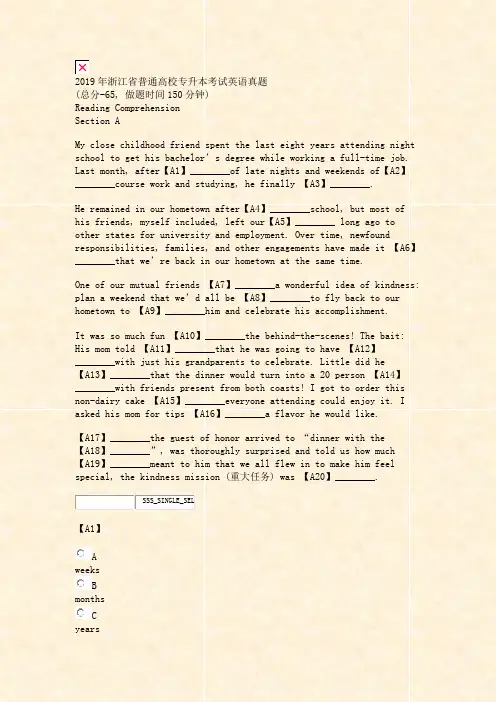
2019年浙江省普通高校专升本考试英语真题(总分-65, 做题时间150分钟)Reading ComprehensionSection AMy close childhood friend spent the last eight years attending night school to get his bachelor’s degree while working a full-time job. Last month, after【A1】________of late nights and weekends of【A2】________course work and studying, he finally 【A3】________.He remained in our hometown after【A4】________school, but most of his friends, myself included, left our【A5】________ long ago to other states for university and employment. Over time, newfound responsibilities, families, and other engagements have made it 【A6】________that we’re back in our hometown at the same time.One of our mutual friends 【A7】________a wonderful idea of kindness: plan a weekend that we’d all be 【A8】________to fly back to our hometown to 【A9】________him and celebrate his accomplishment.It was so much fun 【A10】________the behind-the-scenes! The bait: His mom told 【A11】________that he was going to have 【A12】________with just his grandparents to celebrate. Little did he【A13】________that the dinner would turn into a 20 person 【A14】________with friends present from both coasts! I got to order this non-dairy cake 【A15】________everyone attending could enjoy it. I asked his mom for tips 【A16】________a flavor he would like.【A17】________the guest of honor arrived to “dinner with the【A18】________”, was thoroughly surprised and told us how much【A19】________meant to him that we all flew in to make him feel special, the kindness mission (重大任务) was 【A20】________.SSS_SINGLE_SEL【A1】AweeksBmonthsCyearsDdecades分值: -1答案:C前文提到 eight years,故选 C。

建东职业技术学院《英语应用能力B级强化培训》(课程代码01020070 )试卷(A卷)试卷适用范围:全院09级学生;使用时间:2009-2010学年第II学期;考核形式:考查 ;使用班级: 09级非英语专业 ; 考核方式:闭卷 ; 考试时间:100分钟专业:班级:姓名:学号:得分:Part I: Reading Comprehension (30 points, 2 points for each)Directions: After reading each of the following passages, you will find 5 questions or unfinished statements. For each question or statement there are 4 choices marked A, B, C and D. Y ou should make the correct choice and write the corresponding letter on the Answer Sheet.T ask 1About the year 1900, a small dark-haired boy named Charles Chaplin was often seen waiting outside the back entrances of London theatres. He looked thin and hungry but his blue eyes were determined. He was hoping to get work in show business for he could sing and dance. His parents were music hall artists and he had been born into the life of the stage. And, although his own boyhood was painfully hard, he knew how to make people laugh.His own father had d ied from drinking too much. And his mother wasn‟t really able to look after Charles and his elder half-brother, Sid, because she was often sick in mind and had to be sent into hospital. Even when she was home with them she seemed to live in a different world. Her illness made the boys very sad.As young men, he and his brother traveled to America in a small company of actors and acted in various cities. One day Charles was invited to join a new company that was making film comedies(喜剧). He accepted the offer and soon become popular.By the time he was thirty, Chaplin was the greatest, best known, and best loved comedian in the world. He had formed his own film-making company and was writing and producing his own films. He was welcomed by excited crowds who surrounded him wherever he went. But he worked very hard and had few close friends.1.Charles Chaplin lived in _______ when he was a boy.A. AmericaB. IrelandC. LondonD. a different world2.Chaplin hoped ______ even in his childhood.A. to sing and danceB. to travel to AmericaC. to produce filmD. to be an actor3.From the passage, we know that Chaplin‟s mother ___________.A. was a dance artistB. stayed at home everydayC. had some mental illnessD. could look after her family4.After he accepted the offer by ______, Chaplin became successful and popular.A. a comedy film companyB. a small company of actorsC. his elder brother SidD. a famous company5.When he was ________, he had his own film-making company.A. a childB. about thirty years oldC. going to AmericaD. very oldT ask 2Acting is such an over-crowded profession that the only advice that should be given to a young person thinking of going on the stage is “Don‟t”! But it is useless to try to discourage someone who feels that the he must act, although the chances of his becoming famous are slim. The normal way to begin is to go to a drama school. Then the young actor or actress takes up work with a theatrical company, usually as an assistant stage manager. This means doing everything that there is to do in the theatre: painting scenery, publicity (宣传), taking care of the costumes (舞台服装), and even acting in very small parts. It is very hard work indeed, the hours are long and the salary s tiny.Of course, some people have remarkable chances which lead to fame and success without this long and hard training. Connie Pratt, for example, was just an ordinary girl working in a bicycle factory. A film producer happened to catch sight of her one morning waiting at a bus stop, as he drove past in his car. He stopped and asked if she would like to go to the film studio to do a test, and she thought he was joking. It took the producer twenty minutes to convince Connie that he was serious. The test was successful. And within a few weeks she was playing the leading part opposite one of the most famous actors of the day. But chances like this happen once in a blue moon!6. From the very beginning, the author puts it clearly that acting is a profession___________.A. for ambitious people only.B. for young people onlyC. too difficult for young people.D. sought after by too many.7. For someone who feels he must act, it is very likely that ____________.A. he will become a film star at long last.B. he will be well paid.C. he will end up without becoming a film star.D. he will become a stage manager.8. A few weeks after the test, Connie Pratt found herself ____________.A. as famous as the greatest actor of the world.B. playing the leading female role in the playC. no less famous than the leading actor of the day.D. the most famous actress of the world.9. Which of the following is NOT mentioned as part of an assistant stage manager‟s job?A. Help advertise plays.B. Play minor roles.C. Collect tickets.D. Take care of the dress to be worn on the stage by an actor or actress.10. The concluding sentence “ chances like this happen once in a blue moon” means ___________.A. this is a highly profitable chance.B. this is something highly possible.C. this is something which happens once in while.D. this is very rare chance.T ask 3No author in American literature is better known or more loved than Samuel Langhorne Clemens. Born in Missouri in 1835, he grew up on the banks of the Mississippi River and used the pen name of …Mark Twain ‟. The two novels brought him his greatest fame: Tom Sawyer and Huckleberry Finn. Another book, Life on the Mississippi, told of his adventures on the river boats of that period .It was during the Civil War that Mark Twain‟s life as a writer started .At that time he was working as a newspaper man in Nevada and California. His short story, “The Celebrated Jumping Frog of Calaveras County ”, was an immediate success and his new life began.In 1870, Mark Twain married Olivia Langdon. He had fallen in love with her picture even before he met her. His wife had a great influence on Twain‟s later books.Mark Twain was also a very successful lecturer. His travels around the country giving talks on different kinds of subjects helped make him famous and increased the sale of his books.Tom Sawyer and Huckleberry Finn are considered Twain‟s best works. They are marked by humor and satire and provide his readers with an excellent picture of his time. His last book was completed in 1909, one year before his death. He was then 74 years old.11. Mark Twain is _______________.A. the best known author in American literatureB. the best author in American all the timeC. the best known author in the worldD. the best author in the world12. The book , Life on the Mississippi , told us ____________ .A. his adventures on the MississippiB. his successful way to a writerC. his life as a writerD. his successful lectures13. Which of the following novels made him famous ?A. Tom Sawyer .B. Huckleberry FinnC. Life on the MississippiD. Both A and B14. Mark Twain‟s life as a writer started ____________.A. when he was a boyB. before he got marriedC. after he got marriedD. when he got married15. From the story we can learn that Mark Twain ___________.A. was a good speakerB. was a good readerC. was a poor newspaper manD. could draw wonderful picturesPartⅡ: Vocabulary and StructureDirections: This part is to test your ability to use words and phrases correctly to construct meaningful andgrammatically correct sentences. It consists of 2 sections.Section A (20 points, 1 point for each)Directions: In this section, there are 20 incomplete sentences. You are required to complete each statement by choosing the appropriate answer from the 4 choices marked A), B), C) and D). Y ou should write corresponding letter on the Answer Sheet.16. The bedroom needs __________.A. paintB. to paintC. to be paintedD. being painted17. This is the longest bridge that __________ on Huangpu River.A. is ever builtB. was ever builtC. has ever been builtD. has ever built18. Recently, I had an unusual experience which I would like to __________ with you.A. shareB. talkC. shiftD. change19. According to one survey, ________ the ten biggest quakes to hit the United States, just one struckCalifornia.A. inB. ofC. outD. out of20. __________ from life pressure, many people have to go all out to work until they are tired out.A. To sufferB. Being sufferedC. SufferingD. Having suffered21. When I applied for my passport to be renewed, I had to send a __________ photograph.A. recentB. fashionableC. freshD. modern22. It was Japan __________ launched the war against China.A. thatB. whenC. whomD. which23. The question is worth __________ again.A. discussingB. to discussC. discussed.D. discuss24. ___________ Stella sees a friend in need, she goes all out to help him or her.A. WhereverB. WhateverC. WheneverD. Whoever25. Training is provided, so no __________ experience is required for the job.A. previousB. principalC. followingD. precious26. Chinese football ___________ in Asia because of its methods and strategies in training and practice.A. falls behindB. gives way toC. watches forD. counts on27. Not until I began to work ________ how much time I had wasted.A. I realizedB. did I realizeC. I have realized D have I realized28. ______________trees, our entire world would be a much drier place.A. ForB. ByC. WithD. Without29. He apologized to his wife for having _______ her.A. offendedB. protectedC. objectedD. defended30. I think he has talked too much, what he needs now is more action and _________ talk.A. lessB. fewC. fewerD. little31. ________________ the same treatment again, he is sure to get well.A. GivingB. To givenC. GivenD. Be given32. It will be a great advantage to be able to speak a foreign language, especially if you are__________business.A. toB. withC. onD. in33. Since the computers are used on assembly line, the production cost __________greatly.A. has been reducedB. is reducingC. is reducedD. reduces34. His wife ____________ him washing the supper dishes.A. insisted onB. persuadedC. asked aboutD. talked of35. Will he participate ___________ the coming Art Festival?A. atB. withC. onD. inSection B (10 points, 1 point for each)Directions: There are 10 incomplete statements here. Y ou should fill in each blank with the proper form of the word given in brackets. Write the word or words in the corresponding space on the Answer Sheet.36. He acted as if nothing (happen) _________________.37. My mother received ( little ) ___________ education than my father.38. Either you or he (be) ___________going to attend the meeting.39. Y ou are wasting time ( copy) _________________ the information because it is useless.40. Rich (imagine)_____________ can lead to great invention.41. We could do nothing but (wait) ___________ outside as patiently as possible.42. The majority of the students (ask) _____________ to answer the question failed yesterday.43. It‟s necessary that the exercises (check)_________________up again.44. He didn‟t want more. He said five dollars (be)________enough.45. (fail)_____________ is the mother of success.Part Ⅲ: Matching (10 points, 1 point for each)Directions: The following is a list of nouns or noun phrases. After reading it, you are required to find those items equivalent to those given in Chinese in the table below. Then you should put the corresponding letters in the brackets on the Answer Sheet, numbered 46through 55.A---answer phone I---registered deliveryB---burglar alarm J---office automationC---date-stamp K---time sheetD---electronic display material L---computer packageE---headed paper M---handbookF---office information system N---waste basketG---shorthand O---card-indexH---annual report P---blueprintExample: ( B ) 防盗报警器(G)速记46.()年度报告47. ()电子显示资料48.()计算机程序包49. ()邮戳日期50.()办公自动化51. ()废纸篓52.()印有信头的信纸53. ()录音电话54.()挂号邮件55. ()办公室信息系统Part Ⅳ: Gap Filling (5 points, 1 point for each)Directions: There are three advertisements in this task. After reading it, you are required to complete the statements below it(No.56 through No.60). Y ou should write your answers briefly in not more than 3 words on the Answer Sheet correspondingly.APPOINTMENTSYOUNG Italian girl student speaks English and French, seeks post in a school or family, giving lessons or looking after children. –Write Box L. 1367, The Daily, London, E.C.4.YOUNG man, once an officer, tired of uninteresting office work, is willing to go to any part of the world and to do anything legal; speaks several languages; drives all makes of cars; exciting work more important than salary. – Write Box F.238, The Daily-, London, E.C.4MARRIED couple wanted Gardener, country house 2 miles from Oxford, good bus service; family three adults, five children; wages 9; comfortable rooms with central heating. –Write Box S. 754, The Daily-, London, E.C.56. What kind of work is suitable for the Italian girl?Teaching classes or .57. What foreign languages does the Italian girl know?She knows .58. Why is the young man tired of his office work?Because it is .59. What does the young man think of salary?He thinks that salary is than exciting work.60. What kind of helper are the married couple trying to find?They are trying to find .Part Ⅴ: TranslationDirections: This part is to test your ability to put English sentences into Chinese. It consists of 2 sections. Section A (10 points, 2 points for each as 2-1.5-1-0)Directions:This part, numbered 61 to 65, is to test your ability to translate English into Chinese. After each sentence, you will read four choices of suggested translation. Y ou should choose the best translation and put your choice in the corresponding space on the Answer Sheet.61.It gives us much pleasure to send you the goods asked for in your letter of September 10.A.很高兴发去贵方9月10日来函索购的货物。
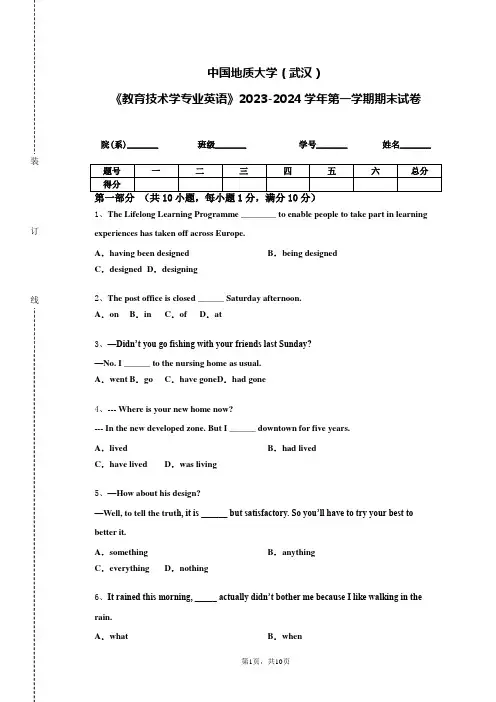
中国地质大学(武汉)《教育技术学专业英语》2023-2024学年第一学期期末试卷院(系)_______ 班级_______ 学号_______ 姓名_______1、The Lifelong Learning Programme ________ to enable people to take part in learning experiences has taken off across Europe.A.having been designed B.being designedC.designed D.designing2、The post office is closed ______ Saturday afternoon.A.on B.in C.of D.at3、—Didn’t you go fishing with your friends last Sunday?—No. I ______ to the nursing home as usual.A.went B.go C.have gone D.had gone4、--- Where is your new home now?--- In the new developed zone. But I ______ downtown for five years.A.lived B.had livedC.have lived D.was living5、—How about his design?—Well, to tell the trut h, it is ______ but satisfactory. So you’ll have to try your best to better it.A.something B.anythingC.everything D.nothing6、It rained this morning, _____ actually didn’t bother me because I like walking in the rain.A.what B.whenC.where D.which7、By the time he realizes the mistake he ________,it will be too late for him to do anything about it.A.has made B.made C.makes D.will make8、The infrastructure of a country is ________ makes everything run well, including things like transport, irrigation, electricity and schools.A.which B.thatC.where D.what9、All of a sudden, the thief walking behind a young and pretty lady _______ her purse,______into the crowd.A.seizing; rushed B.seized; rushed C.seizing; rushing D.seized; rushing10、--- Hello, Tom. This is Mary speaking.--- What a coincidence! I_________ about you.A.just thought B.was just thinkingC.have just thought D.would just think第二部分阅读理解(满分20分)阅读下列短文,从每题所给的A、B、C、D 四个选项中,选出最佳选项。
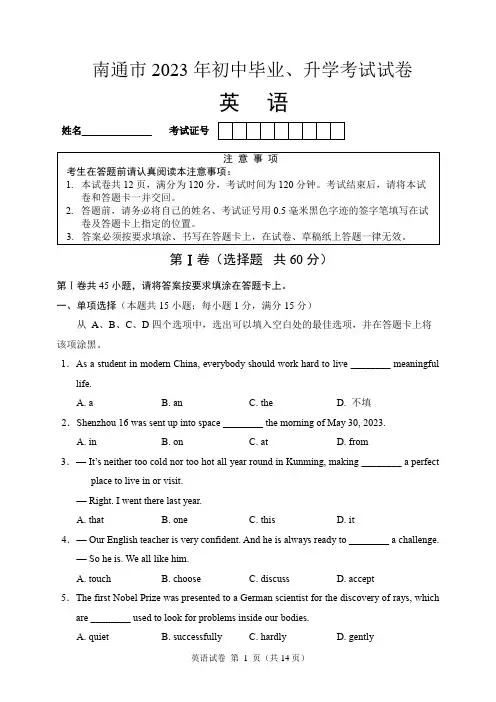
南通市2023年初中毕业、升学考试试卷英语姓名______________考试证号第Ⅰ卷(选择题共60分)第Ⅰ卷共45小题,请将答案按要求填涂在答题卡上。
一、单项选择(本题共15小题;每小题1分,满分15分)从A、B、C、D四个选项中,选出可以填入空白处的最佳选项,并在答题卡上将该项涂黑。
1.As a student in modern China, everybody should work hard to live ________ meaningful life.A. aB. anC. theD. 不填2.Shenzhou 16 was sent up into space ________ the morning of May 30, 2023.A. inB. onC. atD. from3.— It’s neither too cold nor too hot all year round in Kunming, making ________ a perfect place to live in or visit.— Right. I went there last year.A. thatB. oneC. thisD. it4.— Our English teacher is very confident. And he is always ready to ________ a challenge.— So he is. We all like him.A. touchB. chooseC. discussD. accept5.The first Nobel Prize was presented to a German scientist for the discovery of rays, which are ________ used to look for problems inside our bodies.A. quietB. successfullyC. hardlyD. gently6.________ you can’t work out the problem, perhaps you need to ask your classmates for help.A. UnlessB. ThoughC. SinceD. Whether7.— Life is like a road. It isn’t always ________.— I can’t agree more. So we should learn to deal with all kinds of difficulties.A. smoothB. silentC. seriousD. special8.— ________ are easily made, but not easily kept.— That’s true. Once you make one, be sure to keep it.A. SpeechesB. DecisionsC. PromisesD. Suggestions9.The wind energy costs very little and will never ________. Besides, it produces little pollution.A. blow outB. run outC. put outD. break out10.— Excuse me, ________ is the Gengsu Theatre from this hotel?— It’s about ten minutes if you take a taxi.A. how farB. how longC. how soonD. how much11.If a football team wants to enter the World Cup, it ________ become a member of FIFA first.A. mayB. mustC. canD. might12.________ healthy, we’ve got used to washing hands before meals and using public chopsticks.A. KeepingB. KeepC. To keepD. To keeping13.________ it was to see the main sights of the world in the World Park!A. How amazing dayB. How an amazing dayC. What amazing dayD. What an amazing day14.— Mike, your first Dragon Boat Festival in China is coming. Shall we celebrate it together?— I’d love to but could you tell me ________?A. what is the meaning of the festivalB. where we would have the celebrationC. how you usually celebrate the festivalD. when is this year’s Dragon Boat Festival 15.— Thinking creatively and trying bravely are very important to young people.— ________. They’re valuable qualities.A. GreatB. That’s all rightC. ExactlyD. You’d better not二、完形填空(本题共15小题;每小题1分,满分15分)请认真阅读下面短文,从短文后各题所给的A、B、C、D四个选项中,选出最佳选项。
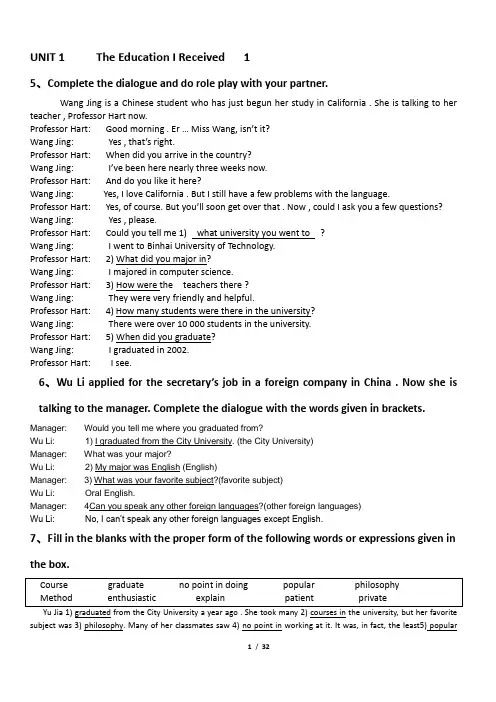
UNIT 1 The Education I Received 15、Complete the dialogue and do role play with your partner.Wang Jing is a Chinese student who has just begun her study in California . She is talking to her teacher , Professor Hart now.Professor Hart: Good morning . Er … Miss Wang, isn’t it?Wang Jing: Yes , that’s right.Professor Hart: When did you arrive in the country?Wang Jing: I’ve been here nearly three weeks now.Professor Hart: And do you like it here?Wang Jing: Yes, I love California . But I still have a few problems with the language.Professor Hart: Yes, of course. But you’ll soon get over that . Now , could I ask you a few questions? Wang Jing: Yes , please.Professor Hart: Could you tell me 1) what university you went to ?Wang Jing: I went to Binhai University of Technology.Professor Hart: 2) What did you major in?Wang Jing: I majored in computer science.Professor Hart: 3) How were the teachers there ?Wang Jing: They were very friendly and helpful.Professor Hart: 4)How many students were there in the university?Wang Jing: There were over 10 000 students in the university.Professor Hart: 5) When did you graduate?Wang Jing: I graduated in 2002.Professor Hart: I see.6、Wu Li applied for the secretary’s job in a foreign company in China . Now she is talking to the manager. Complete the dialogue with the words given in brackets.Manager: Would you tell me where you graduated from?Wu Li: 1)I graduated from the City University. (the City University)Manager: What was your major?Wu Li: 2)My major was English (English)Manager: 3)What was your favorite subject?(favorite subject)Wu Li: Oral English.Manager: 4Can you speak any other foreign languages?(other foreign languages)Wu Li: No, I can’t speak any other foreign languages except English.7、Fill in the blanks with the proper form of the following words or expressions given in the box.Yu Jia 1) graduated from the City University a year ago . She took many 2) courses in the university, but her favorite subject was 3) philosophy. Many of her classmates saw 4) no point in working at it. It was, in fact, the least5) popularsubject in Yu Jia’s class. Yu Jia, however, was 6) method about the teaching 7) enthusiastic, and often had discussions with the teacher, who was 8) patient and liked to 9) explain things to her. She often gave 10) private lessons to her.8、Translate the following sentences into Chinese or English.1. Which university did you graduate from?你毕业于哪所大学?2. What courses did you take?你学过什么课程?3. How many student were there in your university?你们学校有多少学生?4. How were students were there in your university?那里的老师怎么样?5. Could I ask you a few questions about the education you received?我可以问你几个关于你所受教育的问题吗?6. 我毕业于滨海大学。
河北省八所重点中学2024学年高三第一次模拟考试英语试卷注意事项:1.答卷前,考生务必将自己的姓名、准考证号填写在答题卡上。
2.回答选择题时,选出每小题答案后,用铅笔把答题卡上对应题目的答案标号涂黑,如需改动,用橡皮擦干净后,再选涂其它答案标号。
回答非选择题时,将答案写在答题卡上,写在本试卷上无效。
3.考试结束后,将本试卷和答题卡一并交回。
第一部分(共20小题,每小题1.5分,满分30分)1.These diagrams are especially helpful when we have a concrete problem ______ at hand.A.be solved B.to solve C.solved D.being solved2.Leaders of many countries have been trying to what it is that makes China develop so fast in recent years. A.carry out B.figure outC.watch out D.make out3.—The battery in my cell phone is running low.—I that last night before we went to bed.A.was noticing B.have noticed C.would notice D.had noticed4.Why do many students stick to private tutoring _____ they could easily master such knowledge at school? A.unless B.before C.after D.when5._____ is often the case, we have worked out the production plan.A.Which B.When C.What D.As6.––Are the repairs finished yet?––Yes, they ______ when I came back home.A.would be completed B.would completeC.had completed D.had been completed7.I _________ to help you to do homework but I couldn't spare any time. I ________ a composition last night and I'll finish it tomorrow.A.wanted;wrote B.had wanted;was writingC.had wanted;wrote D.wanted;have been writing8.__________ 62% of all luxury consumer sales in Europe in 2015, shoppers from the Chinese mainland spent $7.2 billion overseas during the Spring Festival.A.Accounting for B.Adding toC.Consisting of D.Making up9.Backward somewhat technologically ________ we are for the moment, we have confidence in our ability to catch up in time.A.although B.if C.as D.once10.____ interested in English may join this club.A.Whoever B.All who C.Anyone D.Who11.—Have you found the new flat advertised in the newspaper?— Y es. But the community____ very large and I nearly got lost just now.A.had been B.was C.will be D.is12.Whether the buildings in this area should be pulled down has remained ____;people are still looking for other possible solutions.A.unchallenged B.relevantC.controversial D.contradictory13.—What’s wrong with you?—Oh, I am sick. I ________ so much ice cream just now.A.shouldn’t eat B.mustn’t eatC.couldn’t have eaten D.shouldn’t have eaten14.Tourists are required to _________ local customs and mind their manners when travelling abroad.A.spot B.confirmC.observe D.spread15.—Did you enjoy the party?—Yes. We ___________ well by our hosts.A.were treated B.would be treatedC.treated D.had treated16.The disabled guy was attended throughout his school day by a nurse ________ to guard him.A.to appoint B.appointedC.appointing D.having appointed17.As a(n) ________ and effective method, expressway noise barrier is a primary measure used to reduce traffic noise. A.correctional B.flexible C.economical D.investigative18.A storm buried Illinois under several inches of snow on Tuesday,______at least 100 people dead in traffic accidents. A.to leave B.leaveC.left D.leaving19.After ________________ a sandstorm warning on Sunday evening, meteorologists forecast that dusty weather will continue in parts of the country on Monday.A.breaking off B.calling off C.leaving off D.putting off20.一Would you be so kind as to take this heavy box upstairs for me?一A.It's my pleasure.B.Help yourself.C.Sure,with pleasure.D.Take your time.第二部分阅读理解(满分40分)阅读下列短文,从每题所给的A、B、C、D四个选项中,选出最佳选项。
2021年东南大学少年班考试卷第Ⅰ 卷(共105分)第一部分:听力(共两节,满分30分)略第一节(共5小题;每小题词1.5分,满分7.5分)听下面5段对话。
每段对话后有一个小题,从题中所给的A、B、C三个选项中选出最佳选项,并标在试卷的相应位置。
听完段对话后,你都有10秒钟的时间来回答有关小题和阅读下一小题。
每段对话仅读一遍。
1. Where does this conversation take place?A. In a book store.B. In the street.C. At a bus stop.2. What does the man think he forgot to do?A. Pay the bill.B. Lock his car.C. Take his mobile phone.3. How would the man like to spend his vacation next winter ?A. By swimming.B. By relaxing in the sun.C. By doing outdoor sports.4. What is the man complaining?A. The office needs a new printer.B. The woman isn’t friendly.C. The printer is difficult to use.5. What was the woman trying to do?A. Be on time.B. Run a race.C. Finish her work.第二节 (共 15 小题,每题1.5分,满分22.5分)听下面5段对话或独白.每段对话或独白后有几个小题,从题中所给的A、B、C三个选项中选出最佳选项,并标在试卷的相应位置。
听每段对话或独白前,你将有时间阅读各个小题,每小题5秒钟;听完后,各小题将给出5秒的作答时间。
泉州市2024届高中毕业班质量监测(一)2023.08高三英语(试卷满分:150分,考试时间:120分钟)注意事项:1. 答题前,考生须在试题卷、答题卡规定的位置填写自己的准考证号、姓名。
考生应认真核对答题卡上粘贴的条形码的“准考证号、姓名”与考生本人准考证号、姓名是否一致。
2. 回答选择题时,选出每小题答案后,用铅笔把答题卡上对应题目的答案标号涂黑。
如需改动,用橡皮擦干净后,再选涂其他答案标号。
回答非选择题时,将答案写在答题卡上,写在本试卷上无效。
3. 考试结束,考生须将试题卷和答题卡一并交回。
第一部分听力(共两节,满分30分)做题时,先将答案标在试卷上。
录音内容结束后,你将有两分钟的时间将试卷上的答案转涂到答题卡上。
第一节(共5小题;每小题1.5分,满分7.5分)听下面5段对话。
每段对话后有一个小题,从题中所给的A、B、C三个选项中选出最佳选项。
听完每段对话后,你都有10秒钟的时间来回答有关小题和阅读下一小题。
每段对话仅读一遍。
例:How much is the shirt?A. £ 19.15.B. £ 9.18.C. £ 9.15.答案是C。
1. Who is Jacob?A. An interviewee.B. A personnel manager.C. A secretary.2. What kind of poems does Bob like?A. Humorous poems.B. Romantic poems.C. Realistic poems.3. When can visitors do experiments with water?A. On Tuesday afternoon.B. On Wednesday morning.C. On Thursday afternoon.4. What is the man asking the woman to do?A. Put him through to the director.B. Have a talk with the director.C. Arrange an appointment.5. How did the woman feel about the service?A. Satisfied.B. Disappointed.C. Apologetic.第二节(共15小题;每小题1.5分,满分22.5分)听下面5段对话或独白。
2025年同等学力人员申请硕士学位英语复习试卷及解答参考一、口语交际(共10分)第一题对话内容:Alice: Good morning! I’m Alice, a new student here. What’s your name and what are you studying?Tom: Good morning, Alice! I’m Tom. I’m studying computer science. What about you?Alice: I’m interested in English literature. Is there anything interesting happening around campus?Tom: Yes, there’s a new exhibition for the art students. It’s open to everyone. You should check it out!Alice: That sounds interesting. Maybe we could go together sometime?Tom: Sure, that would be great. Let’s meet tomorrow at the university cafe at 2 PM?Alice: Perfect! I’ll see you then.Tom: Looking forward to it, Alice. Bye!Alice: Bye!题目:1.Who is Alice?A. A new professorB. A new studentC. A computer science studentD. An art student2.What is Tom studying?A. English literatureB. Computer scienceC. ArtD. English3.What is Alice interested in?A. Computer scienceB. English literatureC. ArtD. Mathematics4.What is the new exhibition for?A. Art students onlyB. Computer science studentsC. English literature studentsD. Everyone5.When and where will Alice and Tom meet?A. At 2 PM in the university libraryB. At noon in the art galleryC. At 2 PM in the university cafeD. At 5 PM in the art studio答案:1.B. A new student2.B. Computer science3.B. English literature4.D. Everyone5.C. At 2 PM in the university cafe第二题对话内容:您是李华,一名英语专业的同等学力申请人员。
2024届河南省济洛平许四市高三下学期高考英语模拟试题(三模)注意事项:1. 答卷前,考生务必将自己的姓名、准考证号填写在答题卡上。
2. 回答选择题时,选出每小题答案后,用铅笔把答题卡上对应题目的答案标号涂黑。
如需改动,用橡皮擦干净后,再选涂其他答案标号。
回答非选择题时,将答案写在答题卡上,写在本试卷上无效。
3.考试结束后,将本试卷和答题卡一并交回。
第一部分听力(共两节,满分30分)第一节 (共5小题;每小题1.5分,满分7.5分)听下面5段对话。
每段对话后有一个小题,从题中所给的A、B、C三个选项中选出最佳选项。
听完每段对话后,你都有10秒钟的时间来回答有关小题和阅读下一小题。
每段对话仅读一遍。
1. When does the rainy season start?A. In January. B: In February. C. In November.2. What's wrong with the man's food?A. It's hot. onB. It's salty.C. It's tasteless.3. What is Jennifer learning in school now?A. To make sculptures.B. To take pictures.C. To draw.4. Which room has the man finished decorating?A. The living room.B. The bathroom.C. The kitchen.5. Where are the speakers?A. At a hospital.B. In a classroom.C. At a ball field.第二节(共15小题;每小题1.5分,满分22.5分)听下面5段对话或独白。
每段对话或独白后有几个小题,从题中所给的A、B、C 三个选项中选出最佳选项。
AC 2007-1863: HOSTING/PARTICIPATING IN GLOBAL COLLABORATIVEPACE PROJECTS
Nicole Giullian, Brigham Young UniversityNicole Giullian is an undergraduate student in Mechanical Engineering at Brigham YoungUniversity in Provo, Utah. She will graduate with her Bachelor of Science Degree in MechanicalEngineering in April 2007. While at BYU, Nicole has worked as a research assistant in theParaCAD lab and as a teaching assistant. She also completed two internships in Hartford,Connecticut with the Structural Methods group of Pratt and Whitney.
C. Greg Jensen, Brigham Young UniversityDr. C. Greg Jensen is an Associate Professor of Mechanical Engineering at Brigham YoungUniversity. He has also worked for Boeing, Lockheed, and United Technologies. His currentresearch interests are in the area of integration, optimization and customization of CAx tools, witha second focus in the direct machining of CAD topology.
Jason McCammon, Brigham Young UniversityJason McCammon holds a Bachelor of Science Degree in Mechanical Engineering from BrighamYoung University in Provo, Utah. He also coauthored a paper accepted at the InternationalAssociation of Drilling Contractors/Society of Petroleum Engineer’s Drilling Conference inFebruary 2006.
Brad Brooks, Brigham Young UniversityBrad Brooks graduated from Brigham Young University in April 2007 with a Bachelor ofScience Degree in Mechanical Engineering.
© American Society for Engineering Education, 2007Hosting/Participating in Global Collaborative PACE Projects Abstract Certain obstacles must be overcome in order to realize the benefits of large-scale collaboration projects. Undergraduate engineering curricula currently do not include projects of sufficient scope and diversity to introduce students to the challenges and lessons inherent to participation in global collaborative design projects. Engineering students today largely graduate with little or no skills or experience working on an international team. Universities need to take steps to institute international collaboration projects that prepare undergraduate students for engineering work in the twenty-first century.
Participating in an international collaboration project is a daunting task for a school that has never worked globally before, and launching or hosting such a project likely seems almost impossible because of the numerous obstacles. In 2005-2006, GM/PACE (Partners for the Advancement of Collaborative Engineering Education) sponsored the first international vehicle collaboration project, a senior capstone project that demonstrated how global-scale projects effectively prepare students for future exposure to large-scale collaboration projects in industry. The most important results of this pioneering project were the lessons learned about global collaboration. Sharing these lessons with other schools will facilitate participation in or hosting of global projects.
Using the international vehicle collaboration design project as a case study, this paper will focus on the requirements needed to either host a global collaboration project or be a participant. Because the success of the project depends on effective communication, it will be the primary focus of the recommendations. First, the necessary software and hardware requirements will be outlined, with a focus on collaborative tools. Next, the various types of training needed for students to become completely involved will be described. Finally, other keys to success will be explained: defining overall and local objectives early in the project and tailoring the project requirements at each site to the school’s resources and goals.
Introduction In recent years there has been a movement among large universities to offer students a global experience. However, this movement has been stagnated in the engineering arena by the lack of available resources and instruction in collaboration and working together in a global context. Typically, mechanical engineering capstone classes place students from one school with an industrial company. It has been generally thought that the design and build nature of engineering capstone is so complex that adding multiple companies or teams from a variety of universities would only add chaos to confusion. However, this challenge is faced daily by real world engineers as they work with colleagues, suppliers, subcontractors, etc. from around the world. The “future of many firms will depend upon their flexibility and quick responsiveness”1, especially in regard to global collaboration2. Engineering students who are able to hone collaboration skills during their university experience will have a great advantage in the workforce.